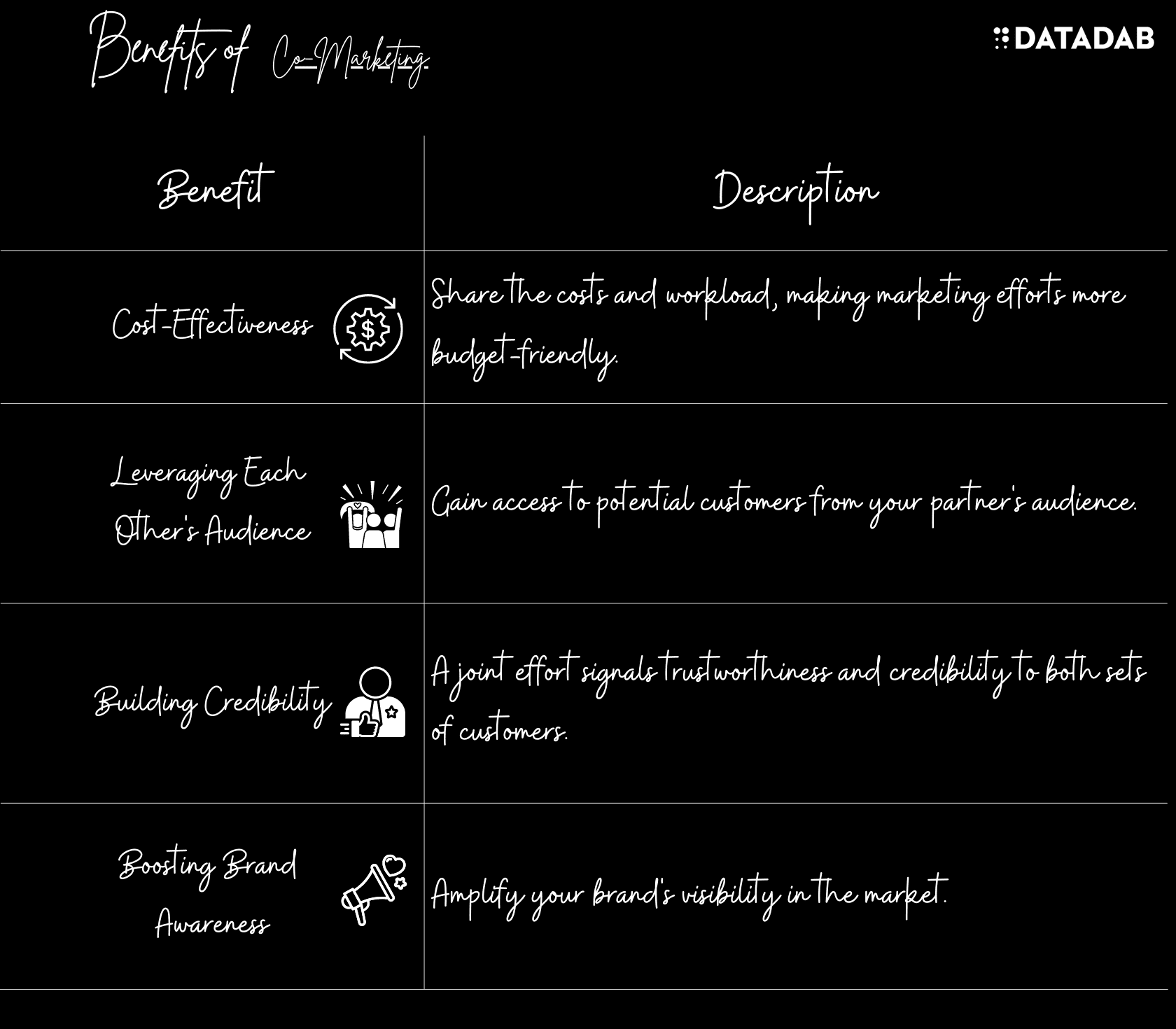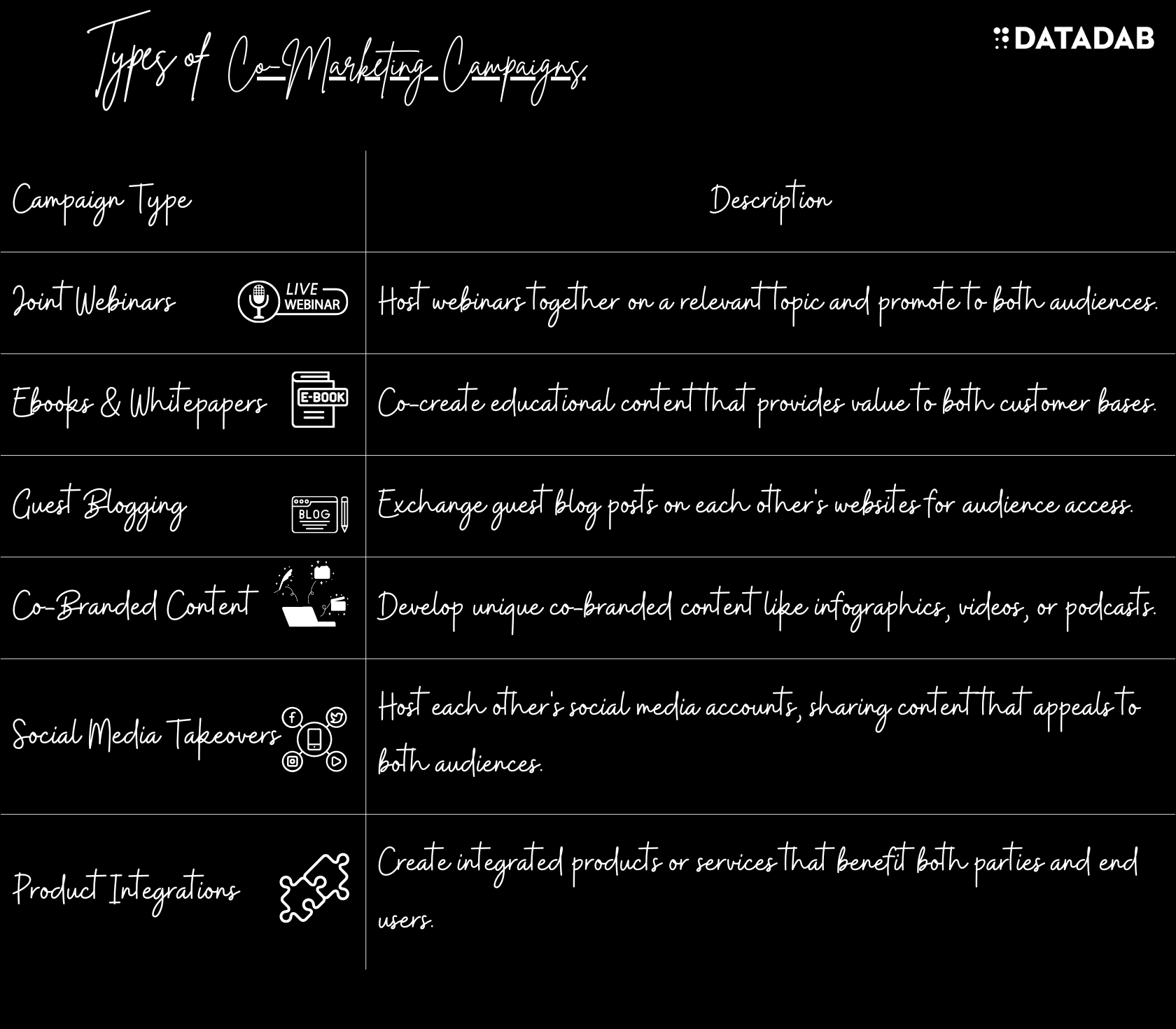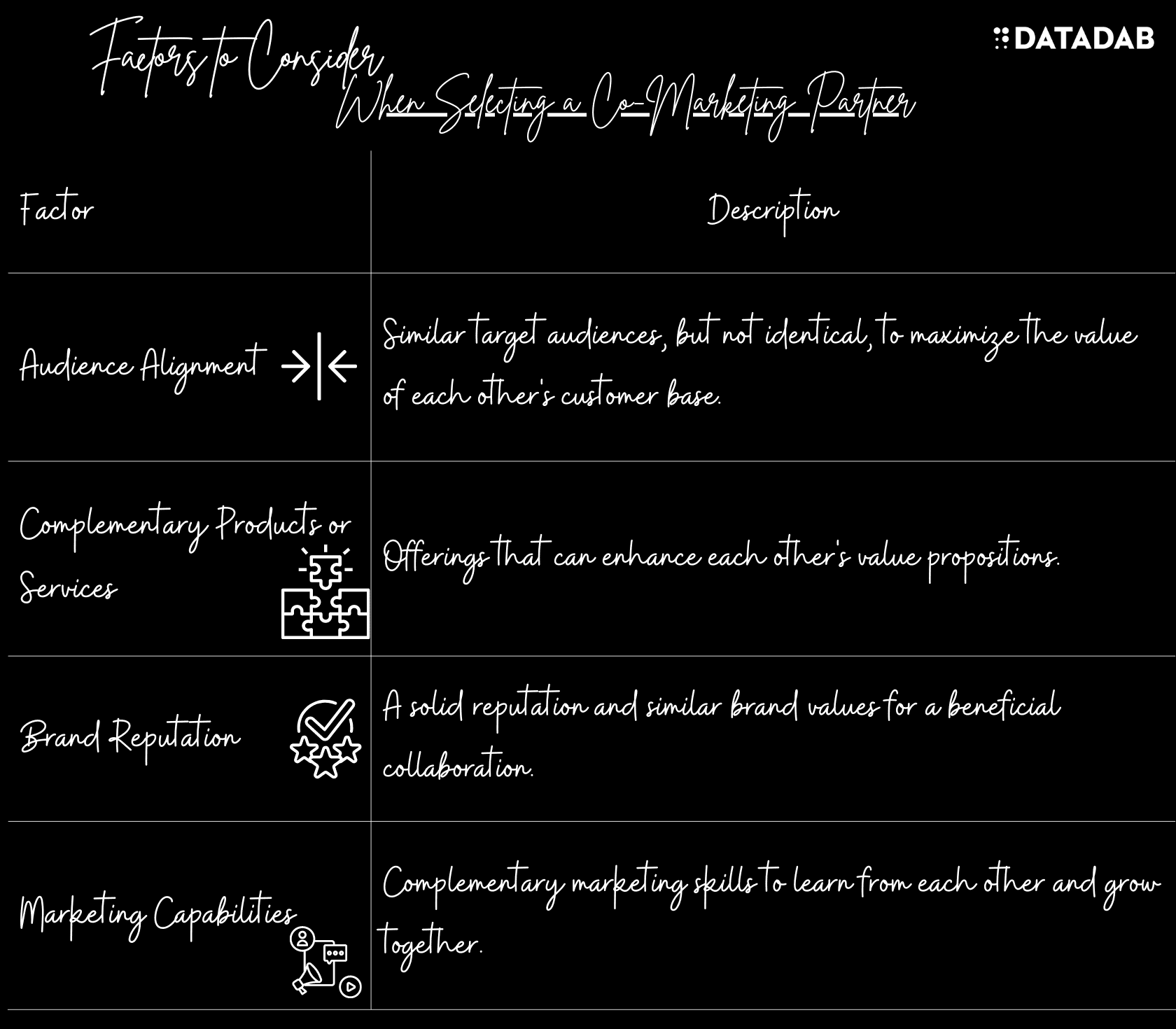"Co-marketing can be a game-changer for SaaS businesses looking to scale their marketing efforts without breaking the bank."
- Steli Efti, CEO of Close.
Hey there, fellow SaaS marketers! 👋 Have you ever found yourself in a situation where you've exhausted your existing marketing channels and struggled to find new ways to grow? Well, you're not alone. In a fiercely competitive landscape, it's not uncommon for marketers to hit a plateau. But fret not, for I have a solution that can reignite your marketing engine: co-marketing!
In this comprehensive guide, we'll delve into the world of co-marketing, uncovering the potential that lies in creating win-win partnerships. It's like meeting a long-lost friend who understands your struggles and is eager to help you grow—while you return the favor, of course.
Table of Contents
- What is Co-Marketing?
- Why Co-Marketing Matters
- Types of Co-Marketing Campaigns
- Selecting the Right Partner
- Collaboration Best Practices
- Measuring Success
- Co-Marketing Case Studies
- Conclusion
1. What is Co-Marketing?
Co-marketing, also known as collaborative marketing, is when two or more businesses team up to promote their products or services together. The goal? To expand their reach, amplify their marketing efforts, and generate new leads by leveraging each other's audience and resources.
Why bother with co-marketing? Well, it's simple. It's a win-win situation: both parties can achieve growth they might not have been able to reach on their own.

2. Why Co-Marketing Matters
There are several reasons why co-marketing matters for SaaS marketers, including:
- Cost-Effectiveness: Co-marketing allows you to share the costs and workload of marketing efforts, making it more budget-friendly.
- Leveraging Each Other's Audience: By collaborating with a partner, you can tap into their audience, giving you access to potential customers you might not have reached otherwise.
- Building Credibility: When two brands join forces, it signals trustworthiness and credibility to both sets of customers.
- Boosting Brand Awareness: Co-marketing can amplify your brand's visibility, making your company more recognizable in the market.
- Learning from Each Other: Working with another company can be an opportunity to learn new strategies, tactics, and best practices that you can implement in your business.

3. Types of Co-Marketing Campaigns
There are numerous ways to collaborate on a co-marketing campaign. Some popular options include:
- Joint Webinars: Host webinars together on a topic relevant to both your audiences and promote the event to both sets of customers.
- Ebooks and Whitepapers: Co-create educational content that provides value to both your customers and your partner's customers.
- Guest Blogging: Exchange guest blog posts on each other's websites, giving both parties access to a new audience.
- Co-Branded Content: Create unique co-branded content, such as infographics, videos, or podcasts, that combines the expertise of both companies.
- Social Media Takeovers: Take turns hosting each other's social media accounts for a day or a week, sharing content that appeals to both audiences.
- Product Integrations: Integrate your products or services in a way that benefits both parties and provides value to the end user.

4. Selecting the Right Partner
Choosing the right partner for a co-marketing campaign is crucial. Here are some factors to consider when looking for the perfect match:
- Audience Alignment: Ensure that your target audiences are similar, but not identical. This way, you can maximize the value of each other's customer base.
- Complementary Products or Services: Look for partners with complementary offerings that can enhance each other's value propositions.
- Brand Reputation: A good partner should have a solid reputation and similar brand values, ensuring that the collaboration is beneficial for both parties.
- Marketing Capabilities: Seek out a partner with marketing skills that complement your own, so you can both learn from each other and grow together.
5. Collaboration Best Practices
Once you've found your ideal partner, it's time to start collaborating. Here are some best practices for a successful co-marketing campaign:
- Set Clear Goals: Clearly outline the objectives of the partnership, such as increasing brand awareness, generating leads, or boosting sales.
- Establish Roles and Responsibilities: Clearly define each party's role in the campaign, ensuring that everyone knows what is expected of them.
- Create a Timeline: Develop a detailed timeline for the campaign, with milestones and deadlines to keep the project on track.
- Communicate Regularly: Schedule regular check-ins to discuss progress, address any challenges, and make adjustments as needed.
- Share Resources: Make it easy for both parties to access shared materials, such as logos, brand guidelines, and content assets.
- Promote Each Other: Cross-promote the campaign through your respective channels, such as email, social media, and your websites.
6. Measuring Success
To determine the success of your co-marketing efforts, it's important to track relevant metrics. Some key performance indicators (KPIs) to consider include:
- Lead Generation: Track the number of new leads generated as a result of the campaign.
- Conversion Rates: Monitor how many leads convert to customers or users, comparing the results to your usual conversion rate.
- Website Traffic: Analyze the increase in website traffic and the sources of those visitors.
- Social Media Engagement: Measure the engagement on social media platforms, such as likes, shares, and comments.
- Content Performance: Assess the performance of shared content, such as page views, downloads, or video views.
7. Co-Marketing Case Studies
To illustrate the power of co-marketing, let's look at a couple of real-life examples:
- HubSpot and Unbounce: HubSpot, an inbound marketing software company, and Unbounce, a landing page builder, joined forces to create a co-branded ebook called "The Conversion Marketer's Guide to Landing Page Copywriting." The collaboration resulted in over 3,000 new leads for both companies.
- Slack and Trello: Slack, a team collaboration tool, and Trello, a project management platform, collaborated on a blog post titled "How to Use Trello and Slack for Team Collaboration." The post was promoted through both companies' social media channels, increasing exposure and driving traffic to their websites.
These examples show that, when done right, co-marketing can lead to impressive results, driving growth for both parties involved.
8. Conclusion
Co-marketing is a powerful strategy for SaaS marketers looking to expand their reach, increase brand awareness, and generate leads. By forming strategic partnerships, companies can leverage each other's strengths and audiences to achieve mutual growth.
To recap, here are the key takeaways for creating successful co-marketing campaigns:
- Understand the benefits of co-marketing and why it matters for your business.
- Explore various types of co-marketing campaigns and choose the one that best suits your goals.
- Select the right partner based on audience alignment, complementary offerings, brand reputation, and marketing capabilities.
- Follow collaboration best practices, such as setting clear goals, establishing roles and responsibilities, and communicating regularly.
- Measure the success of your co-marketing efforts using relevant KPIs and continuously optimize your campaigns.
Now that you're armed with the knowledge and tools you need to create win-win partnerships, it's time to start exploring co-marketing opportunities for your SaaS business. Good luck, and happy collaborating! 🚀
FAQ
1. What is the main objective of co-marketing in the SaaS industry?
The primary objective of co-marketing in the SaaS industry is to create win-win partnerships that drive mutual growth. By collaborating with complementary companies, SaaS businesses can share resources, expand their audience reach, increase brand awareness, and generate leads together. The joint marketing efforts can be more cost-effective and efficient, resulting in better outcomes for both parties.
2. How do I determine if a potential co-marketing partner is the right fit for my SaaS business?
To determine if a potential co-marketing partner is the right fit for your SaaS business, consider the following factors:
- Audience Alignment: Ensure that your target audiences are similar but not identical, allowing you to maximize the value of each other's customer base.
- Complementary Products or Services: Look for partners with complementary offerings that can enhance each other's value propositions.
- Brand Reputation: A good partner should have a solid reputation and similar brand values, ensuring that the collaboration is beneficial for both parties.
- Marketing Capabilities: Seek out a partner with marketing skills that complement your own, so you can both learn from each other and grow together.
3. What are some examples of co-marketing campaign types for SaaS businesses?
Some examples of co-marketing campaign types for SaaS businesses include:
- Joint webinars
- Co-authored ebooks and whitepapers
- Guest blogging
- Co-branded content (e.g., infographics, videos, or podcasts)
- Social media takeovers
- Product integrations
4. How can I ensure a successful collaboration with my co-marketing partner?
To ensure a successful collaboration with your co-marketing partner, follow these best practices:
- Set clear goals for the partnership.
- Establish roles and responsibilities for each party.
- Create a timeline with milestones and deadlines.
- Communicate regularly and transparently.
- Share resources, such as logos, brand guidelines, and content assets.
- Cross-promote the campaign through your respective channels.
5. What are some key performance indicators (KPIs) for measuring the success of a co-marketing campaign?
Some key performance indicators (KPIs) for measuring the success of a co-marketing campaign include:
- Lead generation
- Conversion rates
- Website traffic
- Social media engagement
- Content performance (e.g., page views, downloads, or video views)
6. How can I approach a potential co-marketing partner for collaboration?
When approaching a potential co-marketing partner for collaboration, follow these steps:
- Research the partner and identify potential synergies between your businesses.
- Craft a personalized message or email highlighting the potential benefits of a collaboration for both parties.
- Include specific examples of the types of co-marketing campaigns you envision.
- Offer to schedule a call or meeting to discuss the collaboration further.
7. What should be included in a co-marketing agreement or memorandum of understanding (MOU)?
A co-marketing agreement or MOU should include:
- A description of the co-marketing campaign and its objectives.
- The roles and responsibilities of each partner.
- Ownership of any intellectual property created during the collaboration.
- Confidentiality clauses.
- A timeline for the campaign, including milestones and deadlines.
- Termination clauses and dispute resolution mechanisms.
8. How can we ensure that our co-marketing campaign stays on track and meets its objectives?
To ensure that your co-marketing campaign stays on track and meets its objectives, establish a clear timeline with milestones and deadlines, and set up regular check-ins with your partner. Use project management tools or shared workspaces to streamline communication and keep all parties informed about progress. Monitor the key performance indicators (KPIs) established for the campaign, making adjustments as needed to optimize results.
9. Can we collaborate with more than one co-marketing partner at a time?
Yes, you can collaborate with more than one co-marketing partner at a time, as long as each partnership is aligned with your business goals and you have the resources to manage multiple collaborations effectively. However, it's essential to ensure that the partnerships do not conflict with each other or dilute the impact of your marketing efforts. Carefully assess the compatibility and potential synergies between each partnership to maximize the benefits.
10. How can we maintain a healthy relationship with our co-marketing partner after the campaign has ended?
To maintain a healthy relationship with your co-marketing partner after the campaign has ended, consider the following steps:
- Conduct a joint post-mortem to discuss the campaign's successes, challenges, and learnings.
- Share your gratitude and appreciation for your partner's contributions to the campaign.
- Continue to engage with your partner on social media, sharing and commenting on their content.
- Keep the lines of communication open for potential future collaborations.
- Offer support and introductions to other potential partners or business opportunities.
Maintaining a healthy relationship with your co-marketing partner can open the door to future collaborations and networking opportunities, further enhancing the long-term benefits of your partnership.






